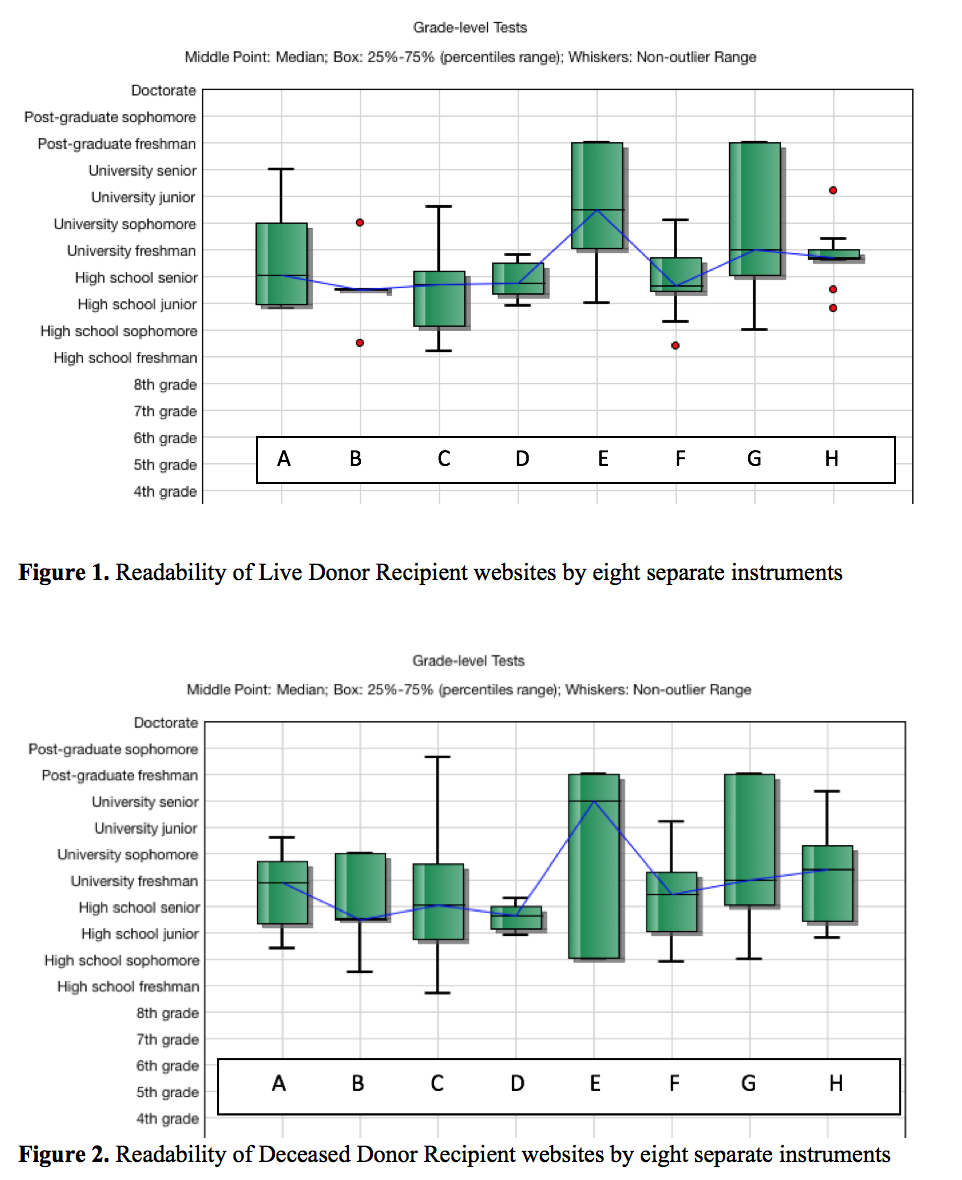Online Patient Resources for Deceased Donor and Live Donor Kidney Recipients: A Comparative Analysis of Readability.
Department of General Surgery and Division of Organ Transplantation, Rhode Island Hospital and Warren Alpert Medical School of Brown University, Providence, RI
Meeting: 2017 American Transplant Congress
Abstract number: C40
Keywords: African-American, Hispanic, Kidney, Kidney transplantation
Session Information
Session Name: Poster Session C: Deceased Donor Issues II: DCD, DGF, AKI, En-Bloc
Session Type: Poster Session
Date: Monday, May 1, 2017
Session Time: 6:00pm-7:00pm
 Presentation Time: 6:00pm-7:00pm
Presentation Time: 6:00pm-7:00pm
Location: Hall D1
Background
The Internet has extensive online resources for kidney transplantation recipients. However, it is unclear if these materials are comprehensible for kidney transplant patients. Nearly, one-half of the US population reads at or below a 7th grade level. Previous studies showed that living donor recipients have statistically significant higher health literacy rates compared to deceased donor recipients. However, there has been no study to date comparing the readability of online living donor recipient materials versus the readability of deceased donor recipient materials.
Methods
Readability analysis was performed using the 8 most common readability scales on the top 10 Internet websites for live donor and deceased donor kidney transplantation. Readability analysis was performed through the Readability Studio Professional Edition Software (Vandalia, Ohio). USA reading grade level was determined for each site.
Results
Overall, the mean reading level for the Living Donor materials was 12.54 (range 9.2-17) and for the Deceased Donor materials, 12.87 (range 8.7-17, P=0.7322), corresponding to a university level. None of the 20 sites met the 7th grade level recommended by the NIH, as evidenced by the 8 readability scales.  Conclusions
Conclusions
The readability of online materials for both living donor recipients and deceased donor recipients remain far too high for the corresponding health literacy rates among patients with chronic kidney disease requiring transplantation. In particular, the lower health literacy rates among patients ultimately receiving deceased donor transplants does not mirror the readability of online materials provided at a university level. This may affect patient comprehension and decision-making, contributing to a smaller proportion of patients of a lower socioeconomic status, minorities, and those with poor English language skills pursuing live donor organs.
CITATION INFORMATION: Zhou E, Kiwanuka E, Cioffi W, Morrissey P. Online Patient Resources for Deceased Donor and Live Donor Kidney Recipients: A Comparative Analysis of Readability. Am J Transplant. 2017;17 (suppl 3).
To cite this abstract in AMA style:
Zhou E, Kiwanuka E, Cioffi W, Morrissey P. Online Patient Resources for Deceased Donor and Live Donor Kidney Recipients: A Comparative Analysis of Readability. [abstract]. Am J Transplant. 2017; 17 (suppl 3). https://atcmeetingabstracts.com/abstract/online-patient-resources-for-deceased-donor-and-live-donor-kidney-recipients-a-comparative-analysis-of-readability/. Accessed December 20, 2025.« Back to 2017 American Transplant Congress
